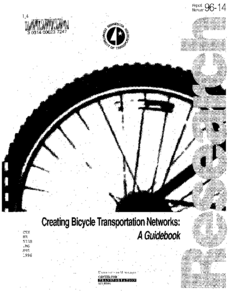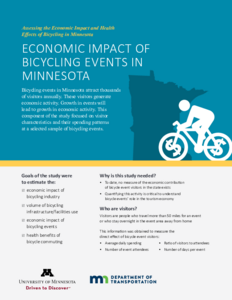Displaying results 1 - 25 of 62
Bicycle Counter
Date Created
2000
Report Number
2000-08
Description
A Guide to Bicycle Transportation in the Twin Cities Metropolitan Area: The Processes, the Players, the Potential
Date Created
2000
Report Number
2000-20
Description
Minnesota's Best Practices for Pedestrian/Bicycle Safety
Date Created
2013
Report Number
2013-22
Description
The Minnesota Bicycle and Pedestrian Counting Initiative: Methodologies for Non-motorized Traffic Monitoring
Date Created
2013
Report Number
2013-24
Description
Investigation of Pedestrian/Bicyclist Risk in Minnesota Roundabout Crossings
Date Created
2012
Report Number
2012-28
Description
Assessing the Economic Impact and Health Effects of Bicycling in Minnesota
Creator
Date Created
2016
Report Number
2016-36
Description
The Minnesota Bicycle and Pedestrian Counting Initiative: Institutionalizing Bicycle and Pedestrian Monitoring
Date Created
2017
Report Number
2017-02
Description
Bicycle and Pedestrian Data Collection Manual
Date Created
2017
Report Number
2017-03
Description
Traffic Impacts of Bicycle Facilities
Date Created
2017
Report Number
2017-23
Description
Bicycle and Pedestrian Data Collection Manual - Draft
Date Created
2015
Report Number
2015-33
Description
The Minnesota Bicycle and Pedestrian Counting Initiative: Implementation Study
Date Created
2015
Report Number
2015-34
Description
Practical Methods for Analyzing Pedestrian and Bicycle Use of a Transportation Facility
Date Created
2010
Report Number
2010-06
Description
Access to Destinations: Application of Accessibility Measures for Non-Auto Travel Modes
Date Created
2009
Report Number
2009-24
Description
Economic Impact of Bicycling Events in Minnesota (Handout)
Date Created
2016
Report Number
2016-36H1
Description
Assessing the Health Benefits of Bicycle Commuting (Handout)
Date Created
2016
Report Number
2016-36H2
Description

























